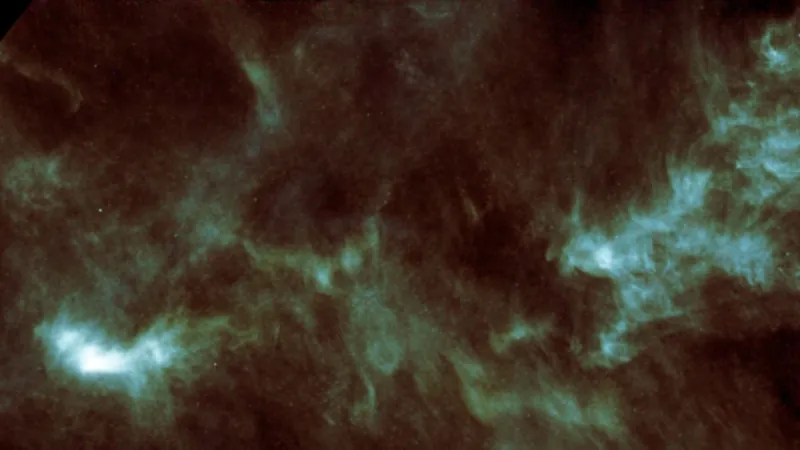
Astronomical Discovery: 'Nitriles' Unearthed in Interstellar Cloud Could Unlock Secrets of Life
2024-11-12
Author: Nur
Introduction
In a groundbreaking discovery, scientists have identified two nitrile-containing molecules in the Taurus molecular cloud (TMC-1), one of the nearest stellar nurseries to Earth. This finding could potentially illuminate our understanding of the origins of life throughout the universe.
Molecule Detection
The Taurus molecular cloud, located in the constellations Taurus and Auriga, revealed the presence of malononitrile and maleonitrile. These molecules were detected through the ongoing QUIJOTE line survey at the Yebes Telescope in Spain. The existence of these nitriles implies that intricate chemical processes are occurring in space, which may offer crucial insights into how life as we know it began.
Significance of Nitriles
Marcelino Agúndez Chico, a researcher at the Instituto de Física Fundamental (CSIC) in Madrid, explained, "Dinitriles, like malononitrile, are known to be precursors in the prebiotic synthesis of purines and pyrimidines, the building blocks of RNA and DNA." As scientists continue to explore the universe's molecular clouds, they are beginning to uncover their role as active chemical laboratories capable of synthesizing prebiotic molecules.
Advancements and Stability of Nitriles
Recent advancements in astrochemistry have allowed for the discovery of an increasing variety of complex molecules in space, fueling excitement among researchers. Agúndez stated, "Cold interstellar clouds are now recognized as incredibly dynamic and chemically rich environments." Among these, nitrile molecules, featuring a triple bond between carbon and nitrogen, have been identified as remarkably stable and abundant.
Interstellar Chemistry Dynamics
Contrary to the chemistry that unfolds on Earth, where reactions favor the most stable products, interstellar chemistry operates differently. In the cold and low-energy environment of space, reactions are often dictated by speed and probability rather than stability. This results in the predominance of quick reactions, capable of forming nitriles that are not as prone to decay or decomposition.
Research Objectives
To further unravel the chemical processes generating these newly detected nitriles in TMC-1, astrochemists aim to pinpoint the reactions responsible for their formation. The research team found that malononitrile and maleonitrile were significantly less prevalent than other similar molecules, indicating unique pathways leading to their synthesis.
Role of Reactive Species
They proposed that a reactive species known as a “radical,” which contributes to the formation of both types of nitriles, was approximately ten times more abundant in its carbon form than the nitrile variant. Agúndez noted that the creation of carbon-carbon triple bond compounds is favored in TMC-1 due to the abundance of hydrocarbons, making it less surprising that carbon-based molecules outnumber nitrile-based ones.
Challenges and Gaps in Current Models
Although the team managed to model a potential reaction pathway for maleonitrile's formation, they faced challenges determining how malononitrile was produced. This gap highlights a broader issue in astrochemistry: the accelerating discovery of new molecules is outpacing existing models’ ability to account for their formation. Many recently discovered molecules, including maleonitrile, have not yet found their way into chemical databases.
Need for Urgent Investigations
"We're discovering an enormous number of molecules in space, and many of them are not included in current reaction networks," Agúndez remarked. He emphasizes that urgent investigations into new reactions are needed to keep pace with these findings and inform future research.
Future Prospects
The researchers are working on solutions and are committed to publishing their findings in due course. This ongoing exploration of TMC-1 and other molecular clouds could eventually lead to a deeper understanding of the conditions and processes that might foster life beyond Earth.
Conclusion
With the insights gained from this study, scientists are building a comprehensive foundational knowledge that may one day unlock the mysteries of life in the universe – and possibly even reveal the existence of life elsewhere. Agúndez expressed optimism: "The chemistry we're uncovering in TMC-1 is likely representative of many other molecular clouds across our galaxy." Stay tuned as this captivating saga of cosmic discovery unfolds!


 Brasil (PT)
Brasil (PT)
 Canada (EN)
Canada (EN)
 Chile (ES)
Chile (ES)
 España (ES)
España (ES)
 France (FR)
France (FR)
 Hong Kong (EN)
Hong Kong (EN)
 Italia (IT)
Italia (IT)
 日本 (JA)
日本 (JA)
 Magyarország (HU)
Magyarország (HU)
 Norge (NO)
Norge (NO)
 Polska (PL)
Polska (PL)
 Schweiz (DE)
Schweiz (DE)
 Singapore (EN)
Singapore (EN)
 Sverige (SV)
Sverige (SV)
 Suomi (FI)
Suomi (FI)
 Türkiye (TR)
Türkiye (TR)